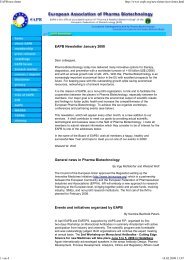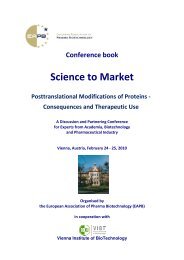Peter Schulz-Knappe
Peter Schulz-Knappe
Peter Schulz-Knappe
You also want an ePaper? Increase the reach of your titles
YUMPU automatically turns print PDFs into web optimized ePapers that Google loves.
Autoantibodies for Patient Stratification –<br />
Protein Arrays and beyond<br />
EAPB, Berlin 2011<br />
Dr. <strong>Peter</strong> <strong>Schulz</strong>-<strong>Knappe</strong><br />
Diagnostics<br />
peter.schulz-knappe@protagen.de<br />
Protagen AG<br />
Otto-Hahn-Str. 15<br />
44227 Dortmund<br />
+49 231 9742 6300<br />
www.protagen.de
Biomarker qualities<br />
� Clinical Biomarkers<br />
- Risk Assessment<br />
- Screening<br />
- Prognostic markers<br />
- Disease Stratification<br />
- Therapeutic monitoring<br />
�� Biomarkers for drug discovery and development<br />
- Mechanism (PoM)<br />
- Toxicity<br />
- Efficacy (PoC)<br />
- Patient stratification (responder/non-responder)<br />
- Surrogate for clinical endpoints<br />
Diagnostic companies<br />
Antibody-based?<br />
Pharma companies<br />
Fit-for purpose assays<br />
� In each case, biomarkers may support the move to personalised medicine
Status of Pharmaceutical Industry 2011<br />
Pharmaceutical R&D<br />
• Duration<br />
• Costs<br />
• Risk<br />
• 12-13 year average from first synthesis to market approval<br />
• R&D cost per NME in 2001 estimated at €870 million<br />
• 92% of NME’s tested in phase 1 will fail to reach market<br />
• Only 30% of marketed medicines produce revenues that meet or<br />
exceed average R&D cost<br />
• Many drugs work in a small population of patients with the intended<br />
disease indication<br />
After M. Bottcher, Bayer Healthcare<br />
Is molecular targeting and individual treatment the future?
Status of Pharmaceutical Industry 2011<br />
Pharmaceutical Industry – Quo Vadis? Prof. Axel Kleemann, January 2011<br />
- 4 -
Status of Pharmaceutical Industry 2011<br />
Pharmaceutical Industry – Quo Vadis? Prof. Axel Kleemann, January 2011<br />
- 5 -
Status of Pharmaceutical Industry 2011<br />
Pharmaceutical Industry – Quo Vadis? Prof. Axel Kleemann, January 2011<br />
- 6 -
Status of Pharmaceutical Industry 2011<br />
Pharmaceutical Industry – Quo Vadis? Prof. Axel Kleemann, January 2011<br />
- 7 -
Major Pharma M&A´s<br />
Acquirer Target company Year Deal $ billion<br />
Novartis (Ciba-Geigy) Sandoz 1996 26<br />
Astra Zeneca 1999 35<br />
Pfizer Warner Lambert 2000 90<br />
GSK Smith Kline & French 2000 55<br />
Pfizer Pharmacia 2003 57<br />
Sanofi-Synthelabo Aventis (former Hoechst) 2004 62<br />
Novartis Alcon 2009/10 39/28<br />
Pfizer Wyeth 2009 68<br />
Merck & Co Schering-Plough/Organon 2009 41<br />
Bayer Schering AG 2006 20<br />
Roche Genentech 2009 47<br />
Sanofi-Aventis Genzyme ? 2011 ? ?<br />
...to be continued...<br />
The consequences are job lay-offs, plant (site) closures,<br />
reduction of R&D projects, contract manufacturing deals in Asia,...!<br />
- 8 -
Status of Pharmaceutical Industry 2011<br />
IMS Health ́s world pharma rankings<br />
2006 Rank 2011 Rank<br />
1 USA USA<br />
2 Japan Japan<br />
3 France China<br />
4 Germany Germany<br />
5 Italy France<br />
6 Canada Italy<br />
7 Spain Brasil<br />
8 UK Canada<br />
9 China Spain<br />
10 Brasil UK<br />
11 Mexico Russia<br />
12 Australia India<br />
13 South Korea South Korea<br />
14 Russia Australia<br />
15 India Mexico<br />
16 Turkey Turkey<br />
Pharmaceutical Industry – Quo Vadis? Prof. Axel Kleemann, January 2011<br />
- 9 -
Status of Pharmaceutical Industry 2011<br />
Pharma layoffs<br />
2009:<br />
• Total layoffs: 61,109<br />
thereof Pfizer (19,500), Merck & Co (16,000), J&J (8,900),<br />
AstraZeneca (7,400), GSK (6,000), Eli Lilly (5,500)<br />
2010:<br />
• Total layoffs: 53,636<br />
thereof AstraZeneca (8,550), Pfizer (8,480), GSK (5,201),<br />
Roche (4,800), Bayer (4,500), Abbott (3,000), Sanofi‐Aventis<br />
(2,500), Takeda (1,400), Novartis (1,400), Genzyme (1,280)<br />
Pharmaceutical Industry – Quo Vadis? Prof. Axel Kleemann, January 2011<br />
- 10 -
Ok, so the pharmaceutical industry needs to change?
Theranostics and Personalised medicine<br />
The Biomarker Promise<br />
This will happen on the basis of Biomarkers
- 13 -
UNIarray® Technology Platform<br />
Autoantibodies<br />
• are constitutive and dynamic components<br />
of the immune system<br />
• change specifically with the development<br />
of diseases and treatment<br />
• are used for diagnostic purposes<br />
• are attractive for development of novel<br />
serum based diagnostics<br />
• make identification of indication specific<br />
marker panels feasible with UNIarray<br />
Non-disease Disease<br />
SM Slide: 14
Autoantibodies for Patient Stratification<br />
Disease<br />
Responder Non-Responder Adverse effect<br />
Colour Code: Disease Disease Disease<br />
Responder Non-Responder Adverse effect<br />
-15-
The UNIarray ® -Workflow<br />
Disease and<br />
control samples<br />
Patient<br />
Sample<br />
Control<br />
Sample<br />
Disease Non-disease<br />
Screening of 40,000<br />
human expression clones<br />
Bioinformatical analysis:<br />
• Biostatistical ranking<br />
• Support vector<br />
machine<br />
• Neural nets<br />
• Treeboost algorithm<br />
• Threshold algorithm…<br />
Affinity purification of<br />
putative biomarkers,<br />
printing protein biochips<br />
Indication-specific<br />
biomarker panel<br />
Diagnostic Protein Array<br />
-16-
UNIarray ® Projects – Current Status<br />
Indication-specific<br />
Concept<br />
Multiple Sclerosis<br />
Rheumatoid Arthritis<br />
SLE<br />
Prostate Cancer<br />
Pancreatic Cancer<br />
Breast Cancer<br />
Ovarian Cancer<br />
Diabetes Typ I<br />
Parkinson Disease<br />
Alzheimer Disease<br />
Thyroid Disease<br />
Biomarker<br />
Discovery<br />
UNIarray ®<br />
Antigen<br />
Verification<br />
Antigen<br />
Concept ���� MACROarray ���� ����<br />
Antigen<br />
Verification ����<br />
Serum Screening<br />
Biochip Prototype<br />
Clinical<br />
Validation<br />
-17-
Multiple Sclerosis<br />
Initial manifestation<br />
Clinical partners:<br />
Multiple Sclerosis Study<br />
Secondary chronic<br />
progressive MS<br />
Primary chronic<br />
progressive MS<br />
1. Klinikum Lüdenscheid,Dr. Schimrigk, Germany<br />
2. Polyclinic TU Munich, Prof. Hemmer, Germany<br />
3. KTH Stockholm, Prof. Olsson, Sweden<br />
4. Accelerated Cure Project, Waltham, MA, USA, with<br />
collection sites at major US-centers<br />
-18-
Multiple Sclerosis still difficult to diagnose….<br />
Clinical<br />
Symptoms<br />
Current Testing for MS:<br />
MRI of<br />
brain and<br />
spinal<br />
cord¹<br />
Protagen<br />
MS-IVD<br />
Lumbar<br />
Puncture<br />
(CSF²)<br />
¹ MRI of value to exclude other diseases, EUR 400-500 / MRI<br />
² Cerebrospinal fluid<br />
Accurate , 85-95 % sensitivity in<br />
trained laboratories,<br />
Inconvenient procedure with ,<br />
complications such as<br />
headache, numbness,<br />
infections, bleeding and brain<br />
herniation<br />
Diagnosis<br />
Goal: Replace lumbar puncture<br />
Idea:<br />
Predictive, blood based in vitro diagnostic<br />
• better specificity of 90%,<br />
• higher sensitivity of 80%<br />
• robust<br />
-19-
Clinical Partners: Karolinska Sample Bank<br />
Genome wide association study (GWAS) with the<br />
international MS genetics consortium (IMSGC),<br />
Illumina 1 million SNP chip<br />
-20-
Properties of MS TOP V3.0<br />
l Nanoliter (10 -9 L) amounts of sample printed<br />
l Low total incubation volumes (< 150 µl)<br />
l 2,672 of quantitative data points/MS TOP V3.0<br />
“multiplex immunoassays”<br />
l 100 - 180 µm spot size,<br />
analysis with microscopic resolution,<br />
20 fmole/spot of 50 kDa protein = 1 ng/spot<br />
Subarray<br />
MS TOP V3.0<br />
anti-RGS His<br />
-21-
Disease Mapping of MS TOP Chip Antigen Panel<br />
Term No. of Genes<br />
multiple sclerosis 21<br />
breast cancer 14<br />
Alzheimer's Disease 11<br />
diabetes, type 1 10<br />
colorectal cancer 10<br />
schizophrenia 10<br />
hepatitis C 8<br />
Parkinson's disease 8<br />
lung cancer 8<br />
melanoma 7<br />
tuberculosis 7<br />
longevity 7<br />
HIV 7<br />
stomach cancer 7<br />
bladder cancer 7<br />
systemic lupus erythematosus 7<br />
H. pylori infection 6<br />
hepatitis C, chronic 6<br />
arthritis 6<br />
celiac disease 6<br />
bone density 6<br />
Database:<br />
Genetic Association Database<br />
Disease<br />
(archive of human genetic association<br />
studies of complex diseases and<br />
disorders;<br />
http://geneticassociationdb.nih.gov/)<br />
-22
Disease-specific<br />
Concept<br />
Biomarker<br />
Discovery<br />
MACRO/Microarray Screening:<br />
plasma samples of 20+ patients<br />
plasma samples of 20+ controls<br />
Antigen Verification:<br />
plasma samples of 50-100 patients<br />
plasma samples of 50-100 controls<br />
UNIarray ®<br />
Antigen<br />
Verification<br />
Marker Panel Validation:<br />
Serum Screening<br />
Biochip Prototype<br />
plasma samples of 200+ patients<br />
plasma samples of 200+ controls<br />
Multicentric<br />
Retrospective/prospective<br />
-23-
Development of Protein Biomarker Candidates<br />
?<br />
- 24 -
Need to switch from<br />
High content/low throughput technology<br />
to<br />
Medium/low content/high throughput technology,<br />
Ideally with<br />
good/excellent single data point quality<br />
High installed instrument base<br />
FDA-clearance...<br />
- 25 -
Principle of bead based arrays (Luminex)<br />
- 26 -
Generation of BBAs<br />
Bead<br />
count<br />
384 Proteins<br />
Coupling<br />
Coupling Control<br />
Signal<br />
intensities<br />
NEU<br />
- 27 -
BBAs for Antigen/Autoantibody Interaction Assays<br />
Intra-Plate:<br />
Average CV Values of<br />
reference serum<br />
Inter-Plate:<br />
Average CV Values of<br />
reference serum<br />
Plate Mean CV<br />
# 1 5 %<br />
# 2 2 %<br />
# 3 2 %<br />
# 4 2 %<br />
# 5 3 %<br />
# 6 2 %<br />
Mean 3 %<br />
Plate Mean CV<br />
# 1 -6 10 %<br />
- 28 -
Intraassay Performance<br />
MFI<br />
45000<br />
40000<br />
35000<br />
30000<br />
25000<br />
20000<br />
15000<br />
10000<br />
5000<br />
Sera (min. 10 microliter, 1:100)<br />
0<br />
# 91<br />
B07_E2<br />
# 92<br />
E02_E1<br />
# 93<br />
D12_E2<br />
# 94<br />
C03_E1<br />
# 95<br />
G09_E2<br />
# 96<br />
F11_E2<br />
# 97<br />
F09_E2<br />
# 98<br />
F07_E2<br />
# 99<br />
B11_E2<br />
# 100<br />
B08_E2<br />
MS-00030_10_1<br />
MS-00030_10_2<br />
MS-00030_10_3<br />
MS-00030_10_4<br />
MS-00030_g_10_1<br />
MS-00030_15_1<br />
MS-00030_15_2<br />
MS-00030_15_3<br />
MS-00030_15_4<br />
MS-00030_20_1<br />
MS-00030_20_2<br />
MS-00030_20_3<br />
MS-00030_20_4<br />
MS-00030_25_1<br />
MS-00030_25_2<br />
MS-00030_25_3<br />
MS-00030_25_4<br />
MS-00030_30_1<br />
MS-00030_30_2<br />
MS-00030_30_3<br />
MS-00030_30_4<br />
MS-00030_40_1<br />
MS-00030_40_2<br />
MS-00030_40_3<br />
MS-00030_40_4<br />
MS-00030_50_1<br />
MS-00030_50_2<br />
MS-00030_50_3<br />
MS-00030_50_4<br />
MS-00030_250_1<br />
MS-00030_250_2<br />
MS-00030_250_3<br />
MS-00030_250_4<br />
- 29 -
20-plex Test with 20 Samples<br />
Each Sample was measured in Quadruplicates. Table displays CV<br />
• Mean CV of antigens is 6%<br />
• Mean CV of Samples is 6%<br />
• FDA recommends CV < 15%<br />
- 30 -
UNIarray ® -Workflow<br />
Screening Cohort:<br />
Disease/Control Samples<br />
Study Cohort:<br />
Disease/Control Samples<br />
• Screening of antigen/autoantibody interactions<br />
Planar Array<br />
Content: 3000 Proteins<br />
• Validation of Biomarker Panels<br />
Bead Based Array<br />
Content: < 500 Proteins<br />
Data Analysis: Selection<br />
of Identified Antigens<br />
Biostatistical Analysis<br />
Diagnostic Protein Panel<br />
-31-
Development of Protein Biomarkers<br />
- 32 -
Autoantibodies as Companion Diagnostics<br />
Protagen sees a strong rationale to utilise autoantibodies as companion<br />
diagnostics in autoimmune disease and oncology.<br />
Partnership with<br />
• Bayer (Endometriosis)<br />
• BiogenIdec (Multiple Sclerosis)<br />
• Suppremol AG (phase II trial for their novel Lupus Erythematodes<br />
development candidate)
Autoantibodies as Companion Diagnostics<br />
• Benlysta (Human Genome Sciences/Glaxo) was introduced in 4/2011<br />
as the first novel Lupus Erythematodes treatment in 50 years.<br />
• During clinical development, Benlysta failed to reach clinical endpoints<br />
in phase II trials<br />
• Patient stratification against certain Autoantibodies identified the<br />
seropositive patients as responders<br />
• Phase III trials mandating seropositive patients were successful<br />
• Benlysta is expected to reach 1 bn $ sales within 4 years after market<br />
introduction
Explore Terra Incognita
Contact<br />
Protagen AG<br />
Otto-Hahn-Str. 15<br />
44227 Dortmund<br />
Germany<br />
T + 49 231 9742 6300<br />
F + 49 231 9742 6301<br />
info@protagen.de<br />
www.protagen.de<br />
- 36 -


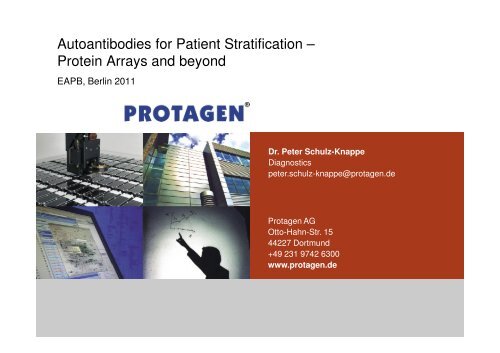
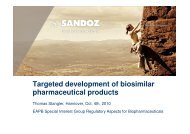
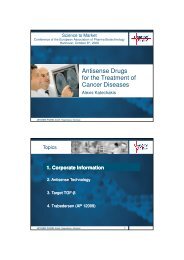
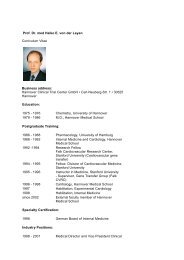


![Roy Forster [Kompatibilitätsmodus]](https://img.yumpu.com/7737040/1/190x135/roy-forster-kompatibilitatsmodus.jpg?quality=85)

